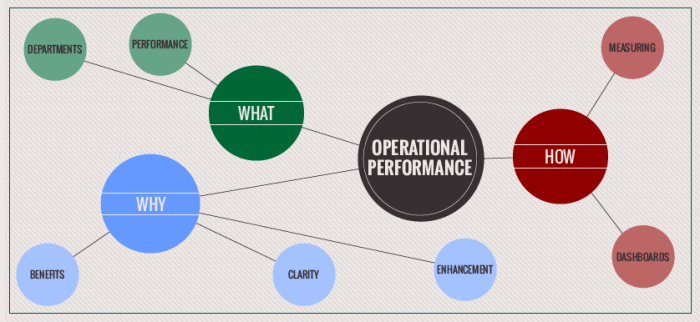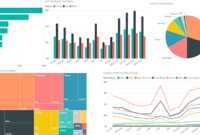Operational performance tracking is crucial for businesses looking to optimize efficiency and productivity. By closely monitoring key metrics and leveraging innovative tools, companies can make informed decisions to drive success and growth.
In this comprehensive guide, we will delve into the importance of operational performance tracking, explore key metrics used for monitoring performance, discuss cutting-edge tools and technologies, and provide solutions to common challenges faced in this area.
Importance of Operational Performance Tracking

Operational performance tracking is a critical aspect of managing businesses effectively. By monitoring and analyzing key operational metrics, organizations can make informed decisions, identify areas for improvement, and optimize their processes for maximum efficiency.
Effective strategic decision-making is crucial for the success of any business. By analyzing data and market trends, businesses can make informed decisions that align with their goals and objectives, leading to sustainable growth and competitive advantage.
Enhancing Overall Efficiency, Operational performance tracking
Tracking operational performance allows businesses to measure their productivity, identify bottlenecks, and streamline workflows. By monitoring metrics such as production output, resource utilization, and cycle times, companies can pinpoint inefficiencies and implement targeted improvements to enhance overall efficiency.
When it comes to BI for small businesses , implementing the right tools can provide valuable insights for growth and decision-making. Small businesses can leverage data to identify trends, track performance, and make informed decisions.
Crucial Industries for Operational Performance Tracking
- Manufacturing: In the manufacturing industry, operational performance tracking is essential for optimizing production processes, minimizing downtime, and ensuring quality control.
- Healthcare: Healthcare organizations rely on operational performance tracking to manage patient flow, reduce wait times, and improve the overall quality of care.
- Retail: Retailers use operational performance tracking to monitor inventory levels, optimize supply chain management, and enhance customer satisfaction through efficient operations.
Key Metrics for Operational Performance Tracking
Operational performance tracking involves monitoring various key metrics to ensure efficiency and effectiveness in operations. These metrics provide valuable insights into the overall performance of a business and help in making data-driven decisions.
1. Cycle Time
Cycle time refers to the total time taken to complete a process or task from start to finish. Measuring cycle time helps identify bottlenecks and inefficiencies in operations. For example, in a manufacturing plant, cycle time can be measured for each production stage to optimize workflow and reduce lead times.
2. Overall Equipment Effectiveness (OEE)
OEE is a metric that measures the performance of equipment in a production environment. It takes into account factors such as availability, performance, and quality to determine the overall efficiency of machines. By tracking OEE, organizations can identify equipment downtime and improve productivity.
3. Inventory Turnover
Inventory turnover is a metric that measures how quickly a company sells and replaces its inventory over a specific period. A high inventory turnover ratio indicates efficient inventory management and reduced carrying costs. By monitoring inventory turnover, businesses can optimize stock levels and avoid overstocking or stockouts.
4. Customer Satisfaction Score (CSAT)
CSAT measures the level of satisfaction customers have with a company’s products or services. By collecting feedback through surveys or customer interactions, businesses can track CSAT scores to identify areas for improvement and enhance customer loyalty. Setting targets based on CSAT metrics can help in delivering better customer experiences.
5. Employee Productivity
Employee productivity measures the output of work relative to the input of labor. Tracking employee productivity metrics such as sales per employee, units produced per hour, or customer service response time can help in evaluating workforce efficiency. Setting targets for employee productivity can drive performance improvements and optimize resource allocation.
Tools and Technologies for Operational Performance Tracking

Tracking operational performance is crucial for the success of any business. In today’s digital age, there are various tools and technologies available that can help organizations monitor and improve their operational efficiency.
Modern Tools for Operational Performance Tracking
Modern businesses can take advantage of a wide range of tools specifically designed for operational performance tracking. These tools offer real-time insights, data visualization, and customizable reporting features to help businesses make informed decisions.
- Enterprise Resource Planning (ERP) Systems: ERP systems integrate different functions of a business into a single platform, providing a comprehensive view of operations.
- Business Intelligence (BI) Tools: BI tools help in analyzing and presenting data to identify trends, patterns, and performance metrics.
- Performance Management Software: These tools focus on setting goals, tracking progress, and evaluating performance against predefined benchmarks.
Comparison of Software Solutions
When choosing a software solution for operational performance tracking, businesses should consider factors such as scalability, integration capabilities, user-friendliness, and cost. Here are some popular software solutions available in the market:
- Tableau: Known for its powerful data visualization capabilities, Tableau helps businesses create interactive dashboards for tracking operational performance.
- SAP Business One: SAP’s ERP solution offers modules for finance, sales, inventory, and more, providing a holistic view of business operations.
- Google Analytics: While primarily used for website analytics, Google Analytics can also be leveraged to track operational metrics and performance.
Benefits of Automated Tracking Systems
Integrating automated tracking systems in businesses can streamline processes, improve accuracy, and enhance decision-making. Some key benefits include:
- Real-time Monitoring: Automated systems provide real-time data updates, allowing businesses to react promptly to changes in performance.
- Data Accuracy: By automating data collection and reporting, businesses reduce the risk of human error and ensure data integrity.
- Efficiency Gains: Automation eliminates manual tasks, saving time and resources that can be allocated to more strategic activities.
Challenges and Solutions in Operational Performance Tracking

Tracking operational performance can come with its own set of challenges that organizations need to address in order to effectively monitor and improve their processes. Let’s explore some common challenges faced in operational performance tracking and discuss potential solutions.
1. Lack of Standardized Metrics
One of the key challenges in operational performance tracking is the absence of standardized metrics across different departments or teams within an organization. This can lead to inconsistencies in data collection and analysis, making it difficult to get a holistic view of the organization’s performance.
- Implement a standardized set of key performance indicators (KPIs) that are relevant to all departments and align with the organization’s overall goals.
- Ensure that all team members are trained on how to collect and report data consistently to maintain uniformity.
- Regularly review and update the metrics to ensure they remain relevant and reflective of the organization’s performance objectives.
2. Data Silos and Integration Issues
Data silos, where information is isolated within different systems or departments, can hinder operational performance tracking by creating gaps in data visibility and accessibility.
- Invest in integrated data management systems that allow for seamless data sharing and collaboration across departments.
- Utilize data integration tools and technologies to consolidate information from disparate sources into a centralized data repository.
- Establish clear data governance policies to ensure data consistency, accuracy, and security across the organization.
3. Limited Resources and Expertise
Organizations may face challenges in operational performance tracking due to limited resources, including budget constraints and a lack of expertise in data analysis and interpretation.
- Provide training and development opportunities for employees to enhance their data analytics skills and capabilities.
- Consider outsourcing data analytics services or investing in automated analytics tools to streamline data processing and analysis.
- Prioritize data quality and invest in data validation processes to ensure accurate and reliable performance tracking results.
Real-World Example:
Company XYZ implemented a cross-functional team to establish standardized KPIs for performance tracking across all departments. By conducting regular training sessions and leveraging automated data integration tools, they were able to overcome data silos and improve operational visibility.
In conclusion, operational performance tracking serves as a cornerstone for businesses striving for operational excellence. By implementing the right strategies and utilizing the latest technologies, companies can overcome challenges and achieve their performance goals effectively. Stay tuned for more insights and tips on optimizing operational performance.
Utilizing business performance analytics can help businesses track key metrics, identify areas for improvement, and optimize performance. By analyzing data effectively, businesses can make data-driven decisions that drive success and profitability.




